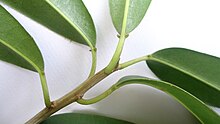Sapium
| Milktrees | |
|---|---|

| |
| Sapium glandulosum | |
| Scientific classification | |
| Kingdom: | Plantae |
| Clade: | Tracheophytes |
| Clade: | Angiosperms |
| Clade: | Eudicots |
| Clade: | Rosids |
| Order: | Malpighiales |
| Family: | Euphorbiaceae |
| Subfamily: | Euphorbioideae |
| Tribe: | Hippomaneae |
| Subtribe: | Hippomaninae |
| Genus: | Sapium Jacq. |
| Synonyms[1] | |
Sapium is a genus of flowering plants in the family Euphorbiaceae.[2][3] It is widespread across most of Latin America and the West Indies.[1][4] Many Old World species were formerly included in the genus, but recent authors have redistributed all the Old World species into other genera.[5]
Species are known commonly as milktrees.[6]
Description
These are shrubs and trees. They produce latex. The leaves are alternately arranged and smooth-edged or toothed. They are monoecious, often with spikelike or raceme-shaped inflorescences that have several male flowers, plus a few female flowers near the base. The male flowers have 2 to 4 stamens. The female flowers have 2 to 4 styles which are sometimes coiled. The flowers lack petals. The fruit has 2 to 4 lobes and may split open or not.
- Species[1]
- Sapium adenodon - Cuba
- Sapium allenii - Costa Rica
- Sapium argutum - Fr Guiana, Suriname, Amapá, Fernando de Noronha
- Sapium ciliatum - Fr Guiana, Suriname, Pará
- Sapium cuneatum - Jamaica
- Sapium daphnoides - Cuba, Hispaniola
- Sapium glandulosum - Mexico, West Indies, Central + S America to Uruguay
- Sapium haematospermum - Brazil, Bolivia, Paraguay, N Argentina, Uruguay
- Sapium haitiense - Massif de la Hotte, Haiti
- Sapium jenmannii - Guyana, Venezuela, Colombia, NW Brazil; naturalised in Trinidad
- Sapium lateriflorum - C + S Mexico, Central America
- Sapium laurifolium - Chiapas, Greater Antilles, Central America, NW South America
- Sapium laurocerasus - Puerto Rico
- Sapium leucogynum - Cuba
- Sapium macrocarpum - Mexico, Central America
- Sapium marmieri - Bolivia, Peru, Ecuador, Colombia, NW Brazil
- Sapium obovatum - Brazil, Bolivia, Paraguay
- Sapium pachystachys - Nicaragua, Costa Rica, Panama
- Sapium pallidum - Bahia, Minas Gerais
- Sapium parvifolium - Cuba
- Sapium paucinervium - NE South America
- Sapium sellowianum - Minas Gerais, São Paulo
- Sapium stylare - Costa Rica, Panama, Venezuela, Colombia, Ecuador
Toxicity
The milky sap of Sapium biloculare is poisonous if it comes into contact with the eyes, mucous membranes, stomach or bloodstream. It was used in arrow poison and to stupefy fish.[7]
References
- ^ a b c Kew World Checklist of Selected Plant Families
- ^ Jacquin, Nicolaus Joseph von. 1790. Enumeratio Systematica Plantarum, quas in insulis Caribaeis 9, 31 in Latin
- ^ Tropicos, Sapium Jacq.
- ^ Govaerts, R., Frodin, D.G. & Radcliffe-Smith, A. (2000). World Checklist and Bibliography of Euphorbiaceae (and Pandaceae) 1-4: 1-1622. The Board of Trustees of the Royal Botanic Gardens, Kew.
- ^ Kruijt, R. C. (1996). A taxonomic monograph of Sapium Jacq., Anomostachys (Baill.) Hurus., Duvigneaudia J. Léonard and Sclerocroton Hochst. (Euphorbiaceae tribe Hippomaneae). Archived 2016-03-04 at the Wayback Machine Biblioth. Bot. 146, 1-109.
- ^ Sapium. Integrated Taxonomic Information System (ITIS).
- ^ Peattie, Donald Culross (1953). A Natural History of Western Trees. New York: Bonanza Books. p. 595.
